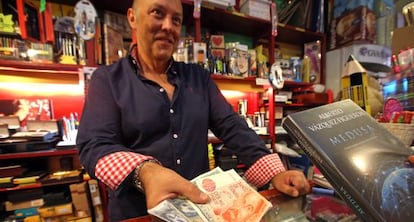Would you like to pay in pesetas?
Over a decade after Spain joined the euro, a handful of stores still accept the old currency

A handwritten sign greets shoppers as they enter La Cebada market in Madrid’s La Latina neighborhood: “In this shop, payment in pesetas accepted.” The stall, called Té y Mi Gordy, sells a huge range of herbal teas. Owner Laura Miso says that in 2002, a few months after the euro had been introduced, she found a 5,000-peseta note in her husband’s suit. Sure that some of her customers must have had similar experiences, she decided to continue accepting pesetas, which the Bank of Spain says can be exchanged up until 2020. In fact, earlier this year it calculated that there were still around €1.669 billion worth of pesetas hidden under people’s mattresses. “The crisis is bad for us all. If you’re finding it hard to make ends meet and you’ve still got a few coins lying around, spend them. Every little helps,” says Miso.
Other establishments have adopted a similar policy. Paloma Jareño, who runs the capital’s two Fantasía de Chocolate cake shops, says she decided to start accepting pesetas 18 months ago. “If you can pay with pesetas, things are going to cost you less,” she says. The decision hasn’t made much difference to her takings, she admits, however: “We have a sign up by the cash register, but only regular customers are aware of the policy, and they tell a few others.”
The Bank of Spain has calculated there are still around €1.669 billion in pesetas hidden under people’s mattresses
Miso says accepting pesetas is another way of making her business stand out from the competition. The sign hanging by her stall attracts tourists and visitors who have their photograph taken next to it. Which isn’t to say that a customer hasn’t surprised her on occasion, such as the lady who had found a pile of notes in her late mother-in-law’s house that added up to €6,000. “I said I didn’t have enough tea to sell her, and that she should take them to the Bank of Spain, but to be careful,” she says laughing.
Jordi Teixidor, owner of El Patufet, an antiques shop in Vilanova i la Geltrú, in Barcelona, has never stopped accepting pesetas. After Spain joined the single currency, he realized that some of his customers were prepared to use up their old money to buy things they wouldn’t spend euros on: “Somebody would get rid of a 5,000-peseta note [€30] on an item, but wouldn’t spend the same amount of euros for it,” says Teixidor. However, he also notes that he hasn’t had a peseta-spending customer for three months.
Somebody would get rid of a 5,000-peseta note on an item, but wouldn’t spend the same amount of euros for it”
Fernando Losada has also seen the potential for making money out of Spain’s former currency. Seven years ago, when he began accepting pesetas at his stationery store in central Madrid, he saw a 50-percent increase in takings. Things have settled since then, but he says he still gets a couple of customers a day who want to pay in “the old money.” They vary from older people who had stashed pesetas away, to younger people who find an old note in a book or coat, or children whose grandparents gave them a piggy bank full of coins. We give people their change in euros, but there are limits: after all, this isn’t the Bank of Spain.”
Tu suscripción se está usando en otro dispositivo
¿Quieres añadir otro usuario a tu suscripción?
Si continúas leyendo en este dispositivo, no se podrá leer en el otro.
FlechaTu suscripción se está usando en otro dispositivo y solo puedes acceder a EL PAÍS desde un dispositivo a la vez.
Si quieres compartir tu cuenta, cambia tu suscripción a la modalidad Premium, así podrás añadir otro usuario. Cada uno accederá con su propia cuenta de email, lo que os permitirá personalizar vuestra experiencia en EL PAÍS.
¿Tienes una suscripción de empresa? Accede aquí para contratar más cuentas.
En el caso de no saber quién está usando tu cuenta, te recomendamos cambiar tu contraseña aquí.
Si decides continuar compartiendo tu cuenta, este mensaje se mostrará en tu dispositivo y en el de la otra persona que está usando tu cuenta de forma indefinida, afectando a tu experiencia de lectura. Puedes consultar aquí los términos y condiciones de la suscripción digital.
Últimas noticias
Maduro pleads not guilty before the federal court in New York: ‘I am still the president of Venezuela’
A new test can detect Alzheimer’s from a finger prick
UN team enters Sudanese city of El Fasher after paramilitary massacre: ‘It’s like a ghost town’
A recipe for resistance: Indigenous peoples politicize their struggles from the kitchen
Most viewed
- Gilles Lipovetsky: ‘If you want to live better and fall in love, take Prozac, don’t look to philosophy’
- Alain Aspect, Nobel laureate in physics: ‘Einstein was so smart that he would have had to recognize quantum entanglement’
- Alvin Hellerstein, a 92-year-old judge appointed by Bill Clinton, to preside over Maduro’s trial in New York
- Why oil has been at the center of Venezuela-US conflicts for decades
- Maduro’s downfall puts China’s relationship with Venezuela to the test








































